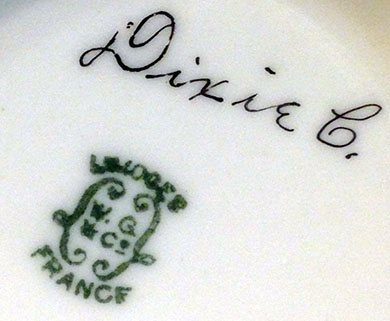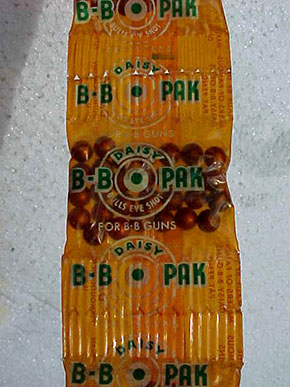 |
|
|||
 |
 |
|||
Copyright © Harry Rinker, LLC 2016 Questions
and Answers
QUESTION: I have an heirloom shaving mug that is passed down through the family to the first son of each ensuing generation. A decorative surround at the top of the body features four-leaf clovers, wishbones, horseshoes, and swastikas. The rim, handle, and bottom collar are painted gold. The bottom has a maker’s mark from France and “Dixie C” in script. How old is my mug? Is the swastika design Nazi related, even though the mug predates the Nazi era? What is it worth? – JH, Goldthwaite, TX, Email Question ANSWER: Your mug began as a while blank that was shipped to America to be painted by an individual who had learned the art of china painting. The mug was manufactured by Wm. Guérin & Co. in Limoges, France. Collectors refer to this circa 1900-1932 mark as “Mark 3.” Ceramic blanks also were supplied to professional painting studios located in America. These studios did not allow decorators to sign their work. Private china painters did. At the beginning of the 20th century, women of means did not work. To fill their leisure time, some took up the hobby of china painting. The art was taught by local artists or learned via a correspondence course. Several import companies issued catalogs containing more than a hundred ceramic blank forms and shapes.
I have no idea who “Dixie C.” is. She most likely painted your mug between 1905 and 1915. If the mug has its origin in your area, try contacting the local historical society to see if they have other hand-painted ceramic examples by this person. Your mug has a Good Luck theme. In addition to the good luck images you mentioned, I also noticed an image of a rabbit’s foot. The swastika, known as an equilateral cross, is an ancient religious symbol found in Hinduism, Buddhism, and many indigenous groups. It dates back to the Neolithic Age. Its mirrored left side image was popular in pre-World War I Europe and used by Germany’s National Socialist Party. Your shaving mug’s primary value is Family/Sentimental. Without any family provenance, its secondary market value is between $25.00 and $35.00. QUESTION: I have a McDonald’s molded, advertising sign that measures approximately 60 inches by 36 inches. The sign features an American eagle holding a banner reading “McDonald’s The American Way.” Initially, the sign was painted gold. Since my first name is Donald, I crossed out the “Mc” and repainted the sign blue. In attempting to learn more about the sign, I found an example on eBay listed for $2,000.00. Should I consider restoring my sign and selling it? – D, Lancaster, PA ANSWER: Even though restoration may simply involve repainting the sign gold, the answer is no. Examples of the sign in its period condition are readily available. In August 2016, an eBay seller listed an example of the sign at a “Buy It Now” price of $499.00. The seller noted the sign is signed and dated “A. M. Gordon Inc. 1971.” His measurements are 61 inches by 28 1/2” inches. The sign appears to be molded Fiberglas with a mounting block. The listing ended with a “no sale” result. On Sunday, August 27, 2016, Morphy Auctions in Adamstown, Pennsylvania, offered an identical sign. The minimum bid was $25.00. The estimate was $100.00 to $200.00. The sign sold for $25.00, the final price being $30.75 once the buyer’s penalty was added. I could not find the $2,000.00 listing that you mentioned. In checking WorthPoint.com, I found an eBay sale that occurred on February 17, 2011 that ended in a sell through price of $999.99. This seller was lucky enough to find the one individual who wanted the sign and did not care what he had to pay for it. Once he was removed from the market, the price plummeted back to reality. Given the information above and the fact that your sign has been repainted, its secondary market value is minimal. Keep it and enjoy it. When your enjoyment ends, put it in a yard sale for $5.00. If it does not sell, send it to the landfill or place in at the curb as bait for a dumpster diver. QUESTION: I have a box of Daisy BB packets. The box, which weighs more than five pounds, is dusty and oil stained. A long strip of individual packages of BBs extends from the top. I have not counted the number of individual packets. The individual packets are cellophane. The BBs inside have no rust and look good. What is their value? – D, Pottsville, PA, Email Question
ANSWER: In the “more than I need to know” category, I came across a BB controversy – copper-coated vs. zinc-coated BBs. Both have a steel core. Some argue that copper-coated BBs are better because they do not rust, are easier to track when fired, and create less friction in the barrel. Others argue that it makes no difference. There seems to be general agreement that Daisy BBs are a better quality than those made by Crossman. On January 27, 2007, Proxibid posted an auction sale of just the box for $5.00. The listing noted the box has a 500 count BB. Since this does not refer to the number of BBs in each individual packet, I assume it means there were 500 packets in the box. Individual older BB packets and tubes sell for between $5.00 and $8.00 each on eBay. This is a case where the value of parts is greater than the whole. If you control the flow into the market, you should be able to average $3.00 to $4.00 per cellophane packet. If you offer the box as it stands on eBay or at a gun show, you might realize $100.00. The difficulty is the condition of the box. QUESTION: I have a brown plastic dinosaur from the 1964-1965 New York’s World’s Fair. What can you tell me about its history and value – F., Reading, PA ANSWER: “Peace through Understanding” was the theme of the 1964/1965 New York’s World Fair. The Unisphere, a 12-story high, stainless steel model of the earth was the Fair’s focal point. The Fair was open from April 22 to October 18, 1964 and April 21 to October 17, 1965. Admission for adults was $2.00. I was one of the individuals who paid. Sinclair Dinoland with its exhibit “The Exciting World of Dinosaurs” was one of the Fair’s pavilions. Sponsored by the Sinclair Oil Corporation, the exhibition featured life-size Fiberglas replicas of nine dinosaurs – Tyrannosaurus, Brontosaurus, Triceratops, Stegosaurus, Ankylosaurus, Corythosaurus, Trachodon, Struthiomimus, and Orintholestes. Sinclair’s “logo” Brontosaurus was 70-feet long. The over 19-foot tall Tyrannosaurus and the Brontosaurus were mechanized. Louis Paul Jonas (1894-1971), who created museum dioramas for the Yale Peabody Museum of Natural History and other institutions, designed and manufactured the replica dinosaurs at his Jonas Studios in Hudson, New York. The project took two years. Paleontologists Barnum Brown and Edward Colbert from the American Museum of Natural History and John Ostrom from the Yale Peabody Museum served as advisors to Jonas. More than 10 million people visited Sinclair Dinoland. Inside was Mold-A-Rama, a machine invented by John H. “Ike” Miller, that allowed visitors to select a dinosaur, insert a quarter, and make a mold of it. The selection included seven dinosaur designs--Brontosaurus, Triceratops, Stegosaurus, Tyrannosaurus, Ankylosaurus, and Corythosaurus. Each was available in a multiple of colors. Collectors refer to these dinosaur figures as “waxy plastic figures.” [Author’s Aside: Mold-A-Rama dinosaurs from the Fair are inscribed “1964-1965 New York World’s Fair.” Sinclair continued to utilize the Mold-A-Rama machine following the close of the Fair. Dinosaurs produced after the close do not have the World’s Fair inscription.] Other souvenirs included a “Bag-O-Dinos” that contained six plastic dinosaurs and sold for 49 cents, a special issue United States map with World’s Fair images on the cover, and a plastic blow up “Dino Playmate.” The most commonly found item is the booklet describing the exhibit. Although the survival rate for Sinclair waxy plastic dinosaurs from the 1964/1965 World’s Fair is high, their value is strong. eBay.com has multiple listings. Individual prices range from $15.00 to over $70.00, depending on the dinosaur and its color. An eBay seller offering a lot of six for $79.99 has elicited no bidders with seven hours left in the auction. Another eBay seller has a “Buy It Now or Best Offer” price of $149.00 on a “Bag-O-Dinos.” It has not sold. WorthPoint.com has over 40 pages of listing. Sell through prices for individual dinosaurs are between $15.00 and $30.00. Your Brontosaurus has a secondary market value between $20.00 and $25.00. Harry L. Rinker welcomes questions from readers about
collectibles, those mass-produced items from the twentieth and twenty-first centuries.
Selected letters will be answered in this column.
Harry cannot provide personal answers.
Photos and other material submitted cannot be
returned.
Send your questions to: Rinker on Collectibles, 5955 Mill
Point Court SE, Kentwood, MI 49512.
You also can e-mail your questions to
harrylrinker@aol.com.
Only e-mails containing a full name and mailing address
will be considered.
You can listen
and participate in
WHATCHA GOT?, Harry’s
antiques and collectibles radio call-in show, on Sunday mornings between 8:00 AM
and 10:00 AM Eastern Time.
If you
cannot find it on a station in your area,
WHATCHA GOT?
streams live on the Internet at www.gcnlive.com.
SELL, KEEP OR TOSS?: HOW TO DOWNSIZE A HOME,
SETTLE AN ESTATE, AND APPRAISE PERSONAL PROPERTY
(House of Collectibles, an imprint of Random House Information Group, $17.99),
Harry’s latest book, is available at your favorite bookstore and via
www.harryrinker.com.
|
||||



